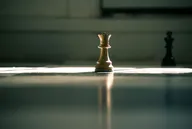Chess and Creativity: flexibility in structures
Pawn structures are not merely static setups: they represent the DNA of a position. Understanding them allows for consistent planning, revealing strengths and weaknesses that can be strategically exploited. They form one of the most solid foundations for training strategic creativity.
A Choice or a Consequence?
Most players do not deliberately choose their pawn structure. It often stems from the chosen opening. Variations may lead to typical structures of the Caro-Kann, Queen’s Gambit, Sicilian, or French. Some support dynamic play; others impose stricter constraints.
A good structure is one that lets you carry out your plan. A bad one doesn’t. Doubled, even tripled pawns, aren’t always bad. Yes, they’re vulnerable. But what really matters is what the pawn structure lets you do.
Reshaping Structure to Create Imbalance
Pawn structures can change. Consciously modifying them is a way to create imbalances, disorient the opponent, and unlock new ideas. Notable games like Short-Timman (1991) and Tomashavksy-Ganguly (2007) demonstrate how structural shifts can lead to fresh strategic opportunities.
Strategic Maps
Certain structures are recurring themes in modern play. Studying them helps recognize typical patterns. Among them:
- Isolated pawn: dynamic potential in the middlegame, but a weakness in endgames.
- Hanging pawns: central control and space, but must be handled actively to avoid stagnation.
- Carlsbad structure: renowned for minority attacks and flexible plans on both wings.
Each case included typical plans for both sides and illustrative diagrams from classic games.
Key Takeaways
To develop a deeper understanding of pawn structures, it helps to know how to recognize, exploit, and consciously modify them. These structures go beyond the opening: understanding their dynamics enables effective planning at all stages. This awareness strengthens strategic consistency and opens the way to creative, unexpected solutions.
- ⚡ Recognize pawn structures to assess them correctly.
- 🔥 Exploit good structures by understanding their strategic value.
- ✨ Reshape structures to create imbalances and new opportunities.
- 🔄 Structures go beyond openings: knowledge of plans outweighs rote theory.
Suggested readings
- “Chess Structures: A Grandmaster Guide” by Mauricio Flores
- “Winning Chess Middlegames Vol. 1 & 2” by Ivan Sokolov
Alberto
Related Posts

The N-Queens Puzzle: A Journey Through Logic and Programming
The N-Queens puzzle is a classic problem of logic and programming that has fascinated chess lovers

Chess and Creativity: artificial intelligence
Artificial intelligence has redefined chess, introducing new ideas and strategies

Chess and Creativity: ingenuity in the shadows
Defense is not just resistance, it is a refined form of creativity. Few players embodied this concept like Tigran Petrosian